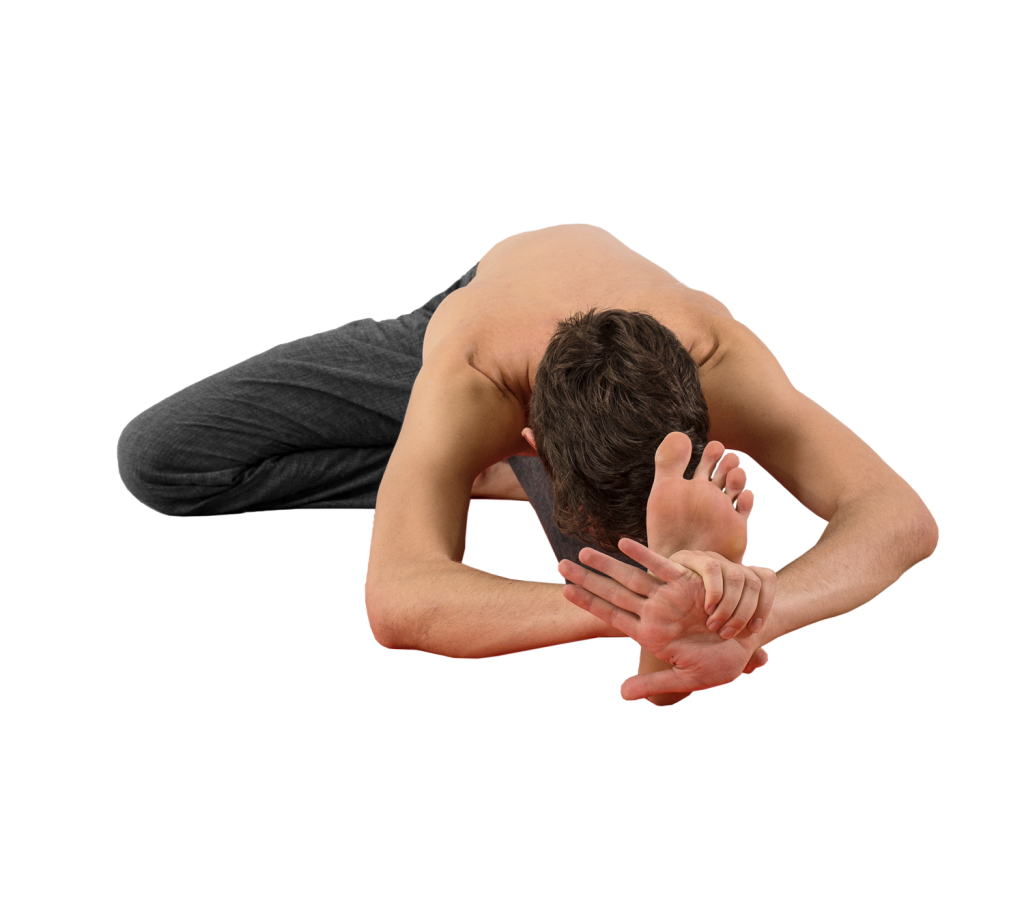Janu Sirsasana B
- Janu: Knee
- Sirsa: Head
- Asana: Pose
Janu Sirsasana B is the twelfth pose of the primary series, and the seventh seated pose. There are three variations of Janu Sirsasana (A, B, C) which differ in foot placement.
The following is a discussion of the position on the right side, as pictured. As an asymmetrical posture, it must be repeated on the left side.
FOCUS ON…
The action of this pose is similar to that of A. The main difference is that the rotation of the femur bone is reversed, so that both legs are in internal rotation. With the leg in this position, full flexion of the knee is ensured by the weight of the body. The bent leg can be arranged at a 50-60° angle. Additional stretch is also possible in the hamstrings of the straight leg.
Janu Sirsasana is a “hip opener,” lengthening the muscles of the inner thigh and groin. The action of the straight leg is that of Paschimottanasana.
There is a slight twisting action in the torso: wrap the length of the spine from root to crown to address the straight leg fully. There can be a tendency for the hips or low belly to face a 45° angle between the femurs, which should be avoided. This is not a posture dedicated to twisting; a ‘counter-twist’ is simply needed to keep facing straight forward.
Principles of Forward Folding:
Vinyasa of the Pose
From Sat, jump through and land in Dandasana.
Inhale, bend both knees slightly. Cross your right leg, so that the shin is perpendicular to the front edge of your mat. Use your hands to lift your body slightly, and sit on the heel. At this point, the top of the foot is fully on the floor and the toes are pointing out from under the left hip. The heel should be in contact with the perineum. Straighten your left leg. Reach your hands upwards, and lengthen your torso.*
Exhale, fold forward and, holding your right wrist, place the hands against the sole of the left foot with the palms facing away from you.**
Inhale and reset, tugging with the strength of the shoulders to pull the chest through the arms, straightening the spine.
Exhale, fold forward fully. This is the state of Janu Sirsasana B; hold for five breaths.
Inhale, sit up and release both hands, placing them to the sides of the hips. Lift your hips slightly, and move your hips back to come off the right foot.
Exhale, jump back and take vinyasa.***
Repeat for the second side.
*Sometimes it is taught that the right toes should be pointed straight forward, towards the front of the mat, however I find this less helpful in encouraging the internal rotation of the femur, flexion of the knee. It also tends to feel unbalanced, since there is no support beneath the left hip.
**Binding the wrist is the preferred method. Alternatives are listed below; if you can hold the wrist, bend the elbows more and more as you gain flexibility to help the torso lengthen.
***Traditionally, vinyasa is taken between sides of asymmetrical postures. If you’re just starting out and building stamina, or have time constraints and require a faster practice, the vinyasa between sides may be omitted
ALTERNATIVES & SOLUTIONS
If the hamstrings feel quite tight, or if you’re unable to sit up straight (the spine is rounding), place a blanket or block beneath the hips. Add additional support if necessary until both the legs and spine can be straightened.
If reaching the toes is challenging or makes you feel crunched, use a strap or towel. Pull the strap with your arms, resist with your feet. This will allow you to feel the interplay between the actions of the arms and the legs that allows the spine to lengthen and the chest to remain full. Otherwise, if you strain yourself to reach the toes, you will likely not be able to find or appreciate the subtleties of the posture. Alternatively, reach to the shin (but do the same pulling action) instead of using a prop.
If you have had knee injury or surgery, and/or feel a pinching sensation when the knee is closed fully in this way, place a rolled up washcloth or piece of fabric behind the knee. When you squeeze the cloth with your knee, the bones of the femur and tibia will be held slightly apart. In the majority of cases, this alleviates or eliminates any pinching sensation or pain. The more severe the injury, the greater amount of cloth should be used. The support can be reduced over time as the joint heals. It’s also helpful when recovering from a knee injury to sit up higher using blankets. If none of these suggestions help, keep practicing Janu Sirsasana A variation and other related poses before integrating this posture.
If your bent knee doesn’t touch the ground, you might find it helpful to place a block under the leg so you can find the sensation of pressing down through the leg.
COMMON MISTAKES
Take the time to figure out how to find the correct—and comfortable—alignment.
Twisting only the upper body or head towards the straight leg shows that the belly and hips are ‘dead,’ or not involved in the pose. Make sure to move from the very low belly.





